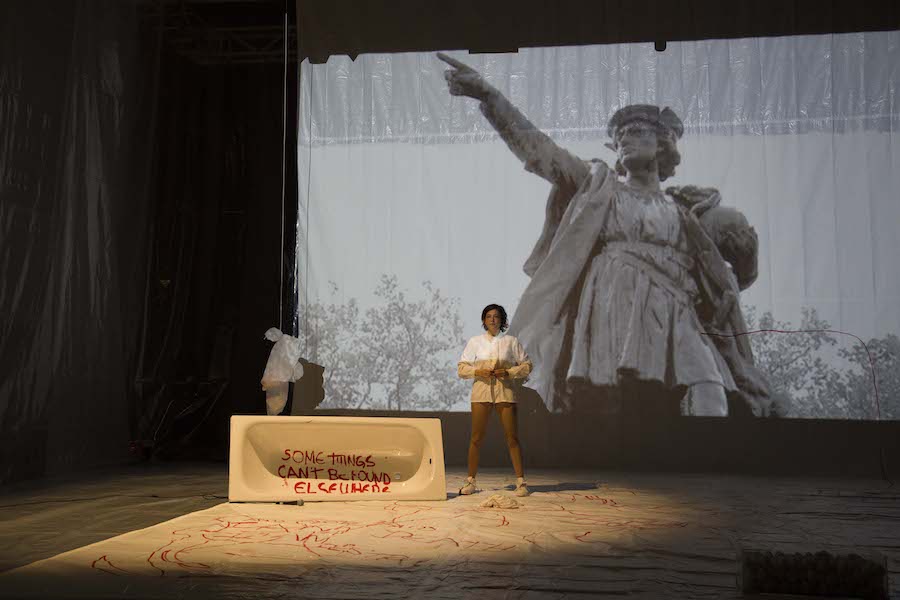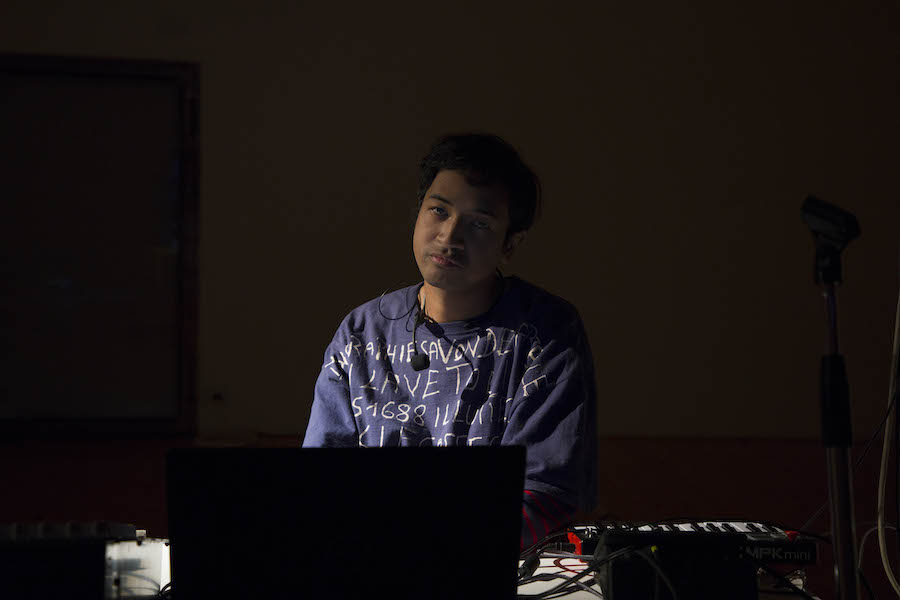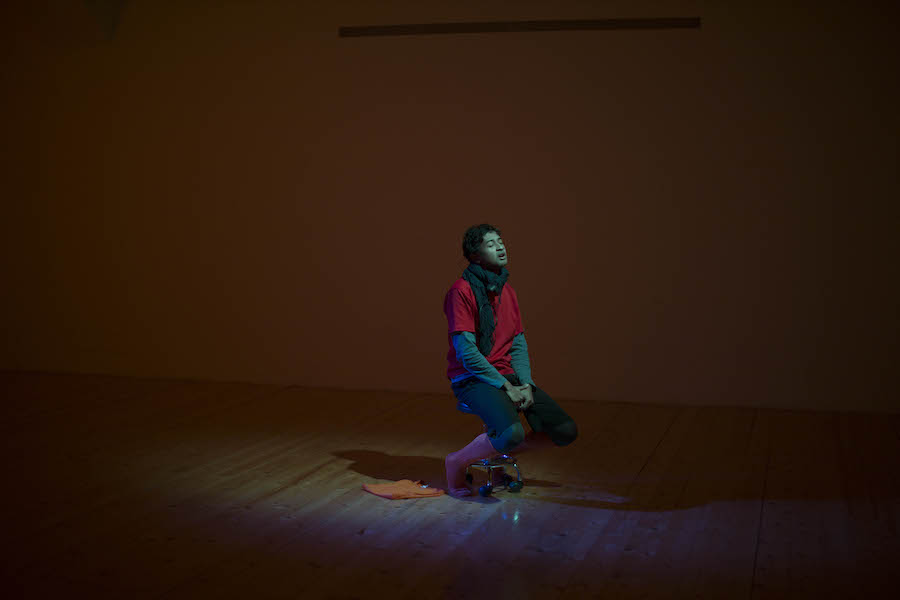

English version below —
Live Works è una piattaforma di ricerca artistica transmediale che riflette, grazie al dialogo e allo scambio tra team curatoriale ed artisti, sulla performance e le arti visive. Grazie a Live Works, Centrale Fies sostiene la sperimentazione di giovani artisti: nato come un evento annuale, oggi si presenta come una piattaforma di ricerca continua, di condivisione tra artisti, curatori e pubblico. Partecipando al progetto, gli artisti coinvolti realizzano una performance inedita, risultato di un processo collettivo di mentoring con il team di Centrale Fies. Quest’autunno, Harilay Rabenjamina e Thais Di Marco hanno presentato, solamente via social a cause delle restrizioni sanitarie, le loro performance inedite, My Honour is Safe e Blood Shower.
Rabenjamina propone My Honour is Safe come un lavoro in progress, che inizia ad assumere forma proprio in occasione della presentazione in streaming. Nel confronto con il pubblico, servendosi di musica e video, l’artista cerca di rispondere alla domanda: “Come narrare un’esperienza?”. Una domanda a cui non ha ancora trovato una soluzione e che si pone costantemente, in un loop infinito, nella realizzazione dei suoi lavori. La domanda è al contempo uno stimolo per raccontare qualcosa o per raccontarla in un modo differente, trovandosi l’artista in difficoltà nel narrare in pubblico delle storie.
Blood Shower è il titolo della performance dell’artista Thais Di Marco, che si interroga su pittura e scultura utilizzati nelle manifestazioni pubbliche, considerati come meri atti vandalici. L’azione di protesta è in realtà provocazione: Thais Di Marco critica il concetto stesso di arte impegnata e politica, che non trova spazio nei luoghi deputati all’arte, come gallerie o istituzioni, perché relegata alla semplice azione di “dimostrazione”. Attraverso ciò che lei stessa definisce come “Action Protesting Painting and Sculpting”, l’artista cerca di attivare un pensiero critico e di stimolare una riflessione sul sistema arte, senza omologazione o censure, in dialogo con il pubblico.
ENGLISH VERSION
Live Works is an artistic research platform in which artists and curators share their experiences in order to develop and explore performance and visual arts. Centrale Fies supports young and emerging artists thanks to Live Works: started as annual event, now it is an active network between artists, curators and spectators. During the residency period at Centrale Fies, the artists realize an inedite work as a result of a collective process: they have, in fact, the opportunity to collaborate with the curatorial team, sharing opinions, feedbacks and critics about their own works. This autumn, Harilay Rabenjamina and Thais Di Marco have presented their performances – My Honour is Safe and Blood Shower – only on social media, due to health restrictions. We have asked them some questions to investigate and discuss their works and their practice.
Veronica Pillon: Harilay Rabenjamina, you joined Live Works, an innovative research platform on performance. What work have you presented and how has your experience at Centrale Fies affected its creation?
Harilay Rabenjamina: I presented a work in progress, a performance called ‘My Honour is Safe’, which is linked to another project I’m still working on: ‘A Guest of Honour’. I had a very good, intense and fun time in Centrale Fies, as I never had so many space and time to work on a performance, outside of my own flat. It was not so easy to present the work that is still early in the process of its creation, but having the perspective of a public presentation during the residency allowed me to make decisive choices that will remain in the final form of the performance.

VP: In your performances, music, songs and video are the protagonists, looking for an answer to the question:” How is it possible to tell an experience?” What is “experience” to you? Have you found an answer to your question?
HR: I guess it’s a question I will never stop to answer by proposing new narratives and new ways to tell a story, on my own scale. I’m not comfortable telling stories, neither to sequence it well nor to voice it publicly, so each time I tell a story is a new challenge to me. And I try to use this uneasiness as a pattern that moves each of my stories forward. I feel like it allows me to talk about a lot of things. My previous performances were about a dog and their master, friendships, RnB bands and now it’s about a love story against a backdrop of political history. Discomfort is so universal, in a good or a bad way, or just in a way that makes something, a story, interesting to be told.
VP: Thais di Marco, you joined Live Works, an innovative research platform on performance. What work have you presented and how has your experience at Centrale Fies affected its creation?
Thais di Marco: I worked on a piece called Blood Shower, where I dedicated myself to the study of techniques of sculpture and painting used in public demonstrations, and that usually don’t have the status of art making, but rather, are commonly called “vandalism”. With this research I proposed a reinauguration of this type of art, calling it “Action Protesting Painting and Sculpting”. Many artists that work in conflict zones are misread as being only “activists” and therefore they don’t have access to spaces, institutions and fundings to keep developing their research. So, I made this art piece using those art techniques to open this debate and start disputing what art institutions call art or non-art, and to honor those who have been fighting for all of us. Some of the techniques I’ve experienced myself in the demonstrations that I was part of. Very few art spaces are courageous enough to select practices that challenge profitable notions, so first of all, I consider Centrale Fies, with its legacy coming from the past, and new policies implemented in the present, a brave institution, showing it’s real commitment to critical thinking and futuristic practices. My work there could grow, and I believe it will be very interesting to show it during the festival in 2021, accessing new audiences and spaces for debate.
VP: Choreographer, theatre stage designer, teacher, and activist. How does the performance help you to address social issues? Do you think it is more effective than other media?
TM: I see performing arts as a public, open source, archive of cosmologies to come. I think performing arts give us the space of actualizing cosmopolitics for futures that we might want to live in, in many ways. It’s something that is always on the horizon of our imagination. I don’t think I am necessarily wanting to address social issues, or that I have the power to do so, or that art can always make that, as it depends pretty much on what context we are talking about. As a thinker, practitioner and maker, what I find important to address politically now, and not through art works, but through public debate, are the issues regarding to how the art market, curators and institutions have been coping with exclusionary selection process, classism, misogyny, racism, nationalism, neoliberalism, industry of fame, and how all those parodistic cycles of power, are emptying and whitening everything that art can become. I think it is important that people that are aware organize to stop cultural homogenization and elitist censorship, standing for art as a practice for permanence of all peoples, in its great variety, and planet Earth.










